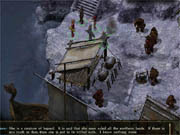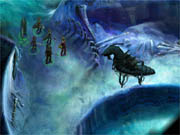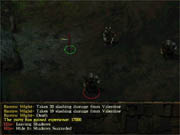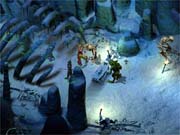Over the last several years, Interplay has gradually established its Black Isle Studios brand as the premier publisher of computer role-playing games. Ever since the science-fiction-themed Fallout in 1997, each of Black Isle Studios' role-playing games has been consistently excellent, and several have already become modern classics: the epic Baldur's Gate, the unforgettable Planescape: Torment, and last year's remarkable sequel, Baldur's Gate II: Shadows of Amn. The original Icewind Dale was also released last year--actually, only a couple of months before Baldur's Gate II. Since it used BioWare's enduring Infinity engine and bore the Dungeons & Dragons license, some players were skeptical about the game: They feared that it was quickly put together to distract them until Baldur's Gate II's release. Fortunately, that wasn't the case. Icewind Dale turned out to be a fun-filled, distinctively action-packed role-playing game that shared only a superficial similarity to other Infinity-engine games. Unfortunately, the official expansion to Icewind Dale, Heart of Winter, is exactly the sort of product that Black Isle fans were worried Icewind Dale might turn out to be. It's a short-lived, uninspired addition to Icewind Dale that costs nearly as much as the original game did and requires that you have the original installed; yet it offers only a fraction of Icewind Dale's value.

However, you wouldn't know it at first: On the surface, Heart of Winter actually promises a lot of new features. Perhaps the most impressive of these is that it raises Icewind Dale's experience-point cap for player characters such that they can all theoretically reach a maximum level of 30--godlike status in the world of Dungeons & Dragons. The expansion offers multiple new special abilities, including a tracking skill for rangers that lets them try to detect an enemy's presence in an area; many new shape-changing abilities for druids; and multiple new spells for clerics and magic users. Heart of Winter also has great production values, much like Icewind Dale before it: The expansion features several new impressive orchestral pieces from the same composer who created Icewind Dale's incredible soundtrack. There are also a lot of new beautifully painted character portraits that you can choose from (though a lot of these have been available for download from Interplay's Web site since Icewind Dale's release). And the voice acting in Heart of Winter is excellent; it includes several new nonplayer characters who deliver all of their lines convincingly. Heart of Winter even includes an all-new "heart of fury" play mode, which makes all of the enemy creatures much more powerful and is suitable for seasoned players who want to continue on with their built-up characters even after they've finished the game.
Heart of Winter's story is based on a minor detail introduced in Icewind Dale. Basically, your party is asked to travel further north and help bring about peace between some powerful barbarian tribes and the nearby community of the Ten-Towns. Soon, you discover evil at the source of the problem--and so you must finally put an end to this vengeful villain. In doing so, you can either export your characters from Icewind Dale or start afresh with pregenerated high-level characters designed for use with the expansion.

In spite of all this, Heart of Winter falls flat as far as the actual game is concerned. The expansion offers only a few new areas to explore, which will collectively require about a dozen hours of your time before you're finished with them. A couple of these areas offer some interesting surprises. At one point, as you pass through a frozen passage, you'll see a ghostly portrait of the blind seer you're seeking materialize momentarily in the reflection of a glacial wall. As in Icewind Dale, the effective use of environmental audio helps bring all these cold, inhospitable places to life. Even so, most of the areas in the expansion simply require that you hike your way through twisting passages that conceal the game's predictably intermittent encounters with groups of monsters. Furthermore, many of these areas simply aren't very interesting; you'll be glad to leave them behind because even if you've played hundreds of hours' worth of Baldur's Gate II since the last time you played Icewind Dale, you'll still recall many of the encounters you'll face in Heart of Winter. When you first squared off against a frost giant in Icewind Dale, it was quite a showdown: The enormous bearded warrior stood many times larger than anything you'd seen up until that point. When you battle the exact same creature in Heart of Winter, you'll be less than impressed. Many other monsters from Heart of Winter are lifted straight from Icewind Dale, such as polar bears, yetis, and snow trolls. In fact, aside from some barbarian warriors, a few new undead foes, the large wormlike remorhaz, and the final battle, there are scarce few new challenges to speak of in Heart of Winter.
Worst of all, these new encounters demand nothing from you that you don't already know how to do if you've already finished Icewind Dale, let alone Baldur's Gate II. For the most part, you can simply order your main fighters to attack head-on. Your magic-users can provide some support, though a lot of the creatures you face are resistant to many types of magic. When you're fighting the undead, you'll want to use your cleric's holy powers against them. In fact, except for the battles against the undead (which you'll face in droves early on in the expansion), you'll have little trouble defeating any of your foes in Heart of Winter. Icewind Dale and Heart of Winter both deliberately avoid some of the more involved, more tactical combat elements of Baldur's Gate and its sequel. You won't have to contend with level-draining attacks nor will you have to think about how to breach an enemy wizard's powerful arcane defenses. But since your characters are already so powerful at the beginning of Heart of Winter (assuming you carry them over from the conclusion of the original Icewind Dale quest), you won't really have to think much at all. Your fighters, assuming you have a couple in your party, will do all the work for you.

One of the best things about Icewind Dale was that you'd get to build up your weak first-level neophytes into extremely powerful high-level warriors over the course of the adventure. The game's strategy was in knowing the limits of your party's power at any given time, since your characters would gain experience relatively quickly. This too is gone in Heart of Winter: Since it's such a short quest, you'll gain just a few more levels during the expansion, which probably won't have a noticeable effect on your characters' performance. You'll have scarce few opportunities to put any of your new spells to use, you'll find little or no purpose for the new magic items you'll find, and there will be hardly any occasion to apply your new skills.
The expansion does offer a few other benefits. You can press a key that highlights all visible doors and dropped items on the screen. Heart of Winter also reintroduces some of the gameplay improvements that first appeared in Baldur's Gate II. These include convenient items for storing gems, spell scrolls, and potions, as well as the ability to hide the game's interface bars, so you can see the action in a full-screen view. Like Baldur's Gate II, the expansion also supports higher resolutions than the original Icewind Dale's locked 640x480-resolution view. All of these enhancements are convenient; none are necessary. They would have made the retail version of Icewind Dale a little better or made for a nice, free downloadable patch--but they're not noteworthy in a $30 expansion.

The fundamental problem isn't that Heart of Winter is a poor game, because it's not. Its battles, its plot, and its impressive production values are all more or less in line with the high standards set by Icewind Dale. But its numerous ancillary improvements actually amount to very little value, considering you can finish the expansion in just a couple of casual play sessions. If you're used to marathon sessions with Baldur's Gate II, or with any Black Isle role-playing game for that matter, then you'll be disappointed by how much shorter Heart of Winter is by comparison. It's true that some players will probably like the inflated challenge of the heart of fury mode after they've finished the expansion quest, particularly because it lets you play through both the expansion and the original Icewind Dale with increased difficulty and proportionally augmented experience rewards. But the mode will be too difficult for a lot of players, while most everyone else won't find it very interesting, since the battles in the game are still scripted. In fact, even the heart of fury mode seems like an afterthought, since you can only toggle it on and off from an external configuration utility, not from within the actual game. In the end, it's not that Heart of Winter isn't worth your time, because it really doesn't take much--the problem is it just isn't worth your money.



